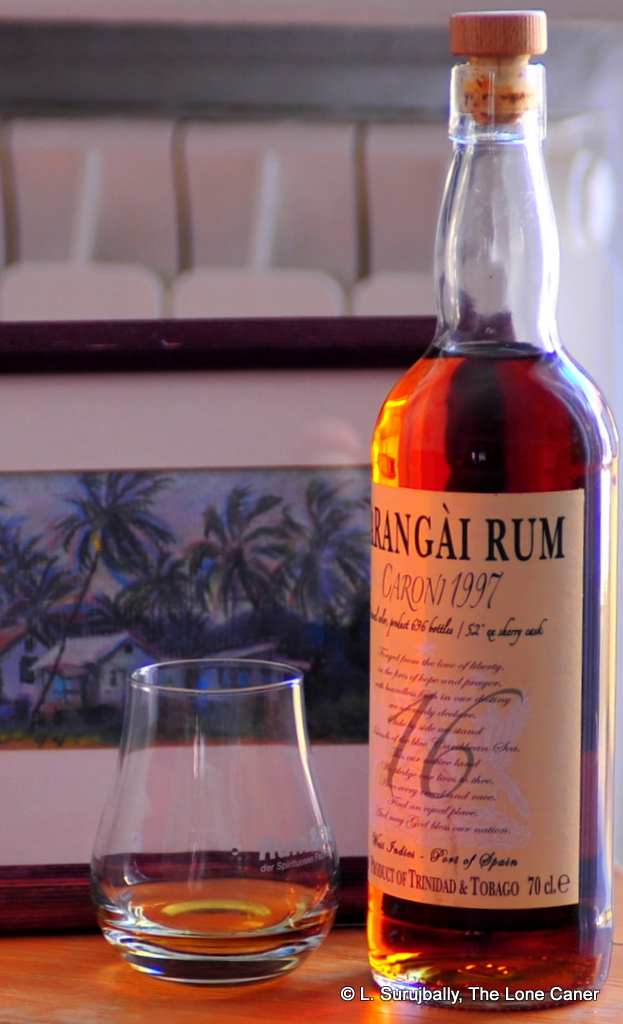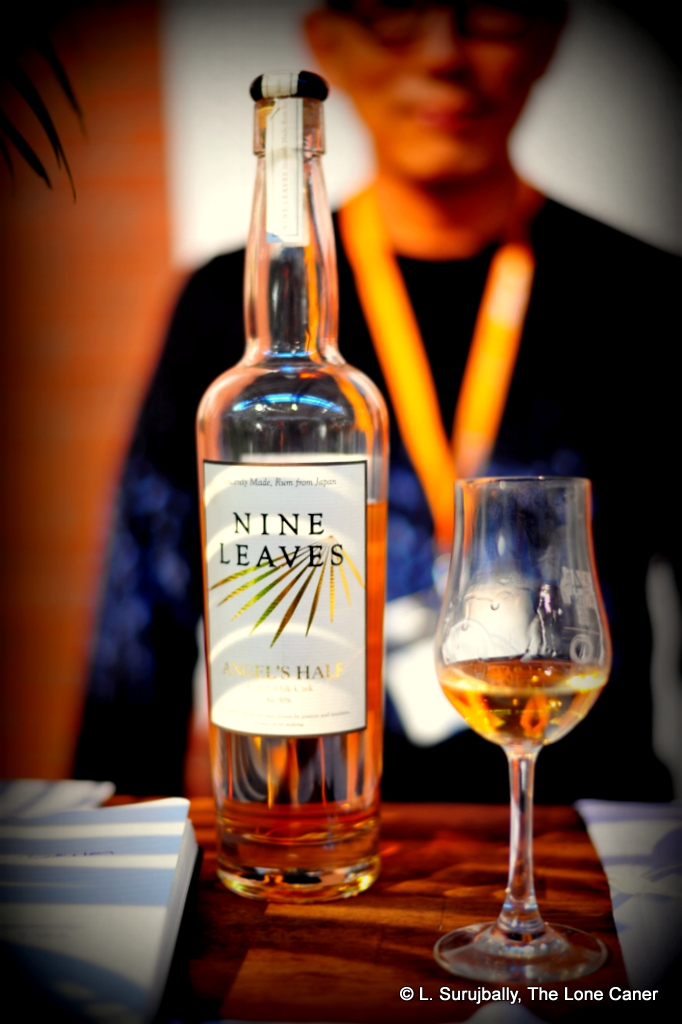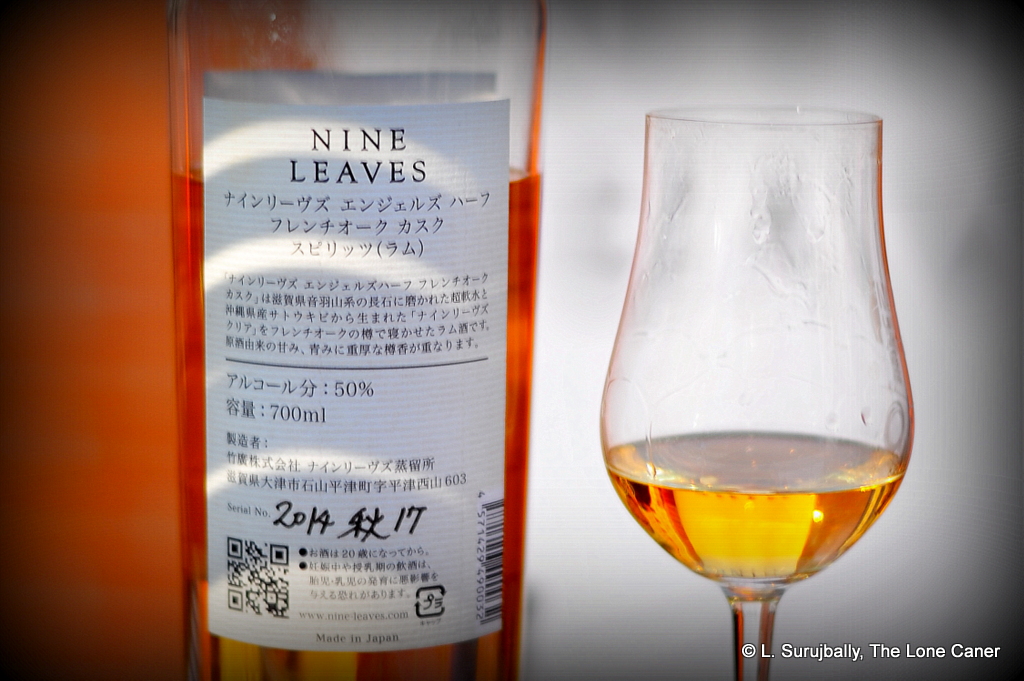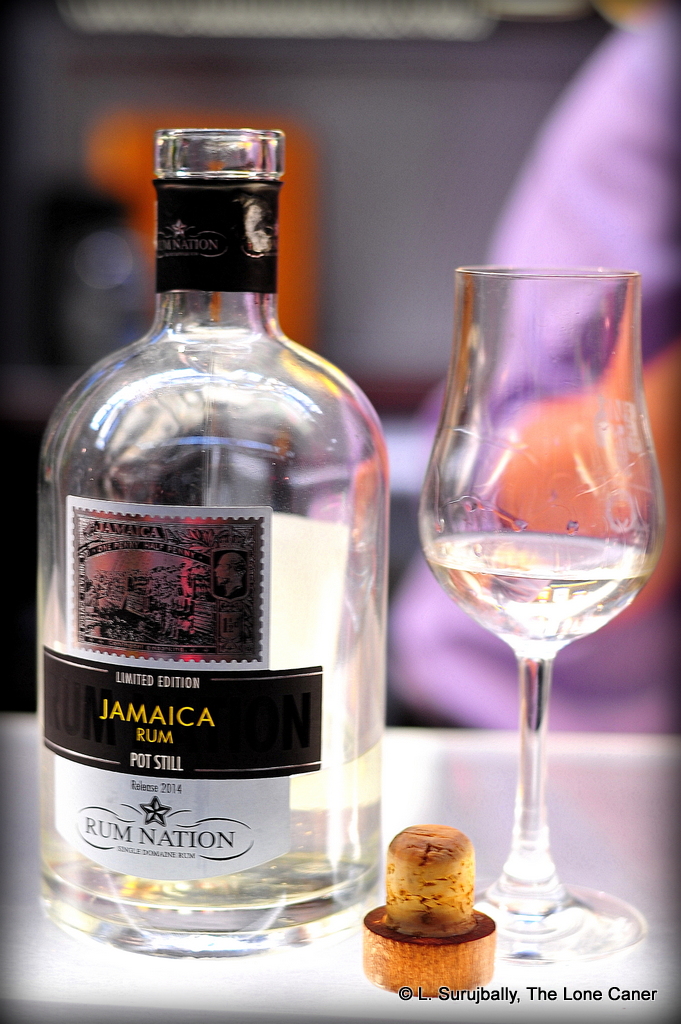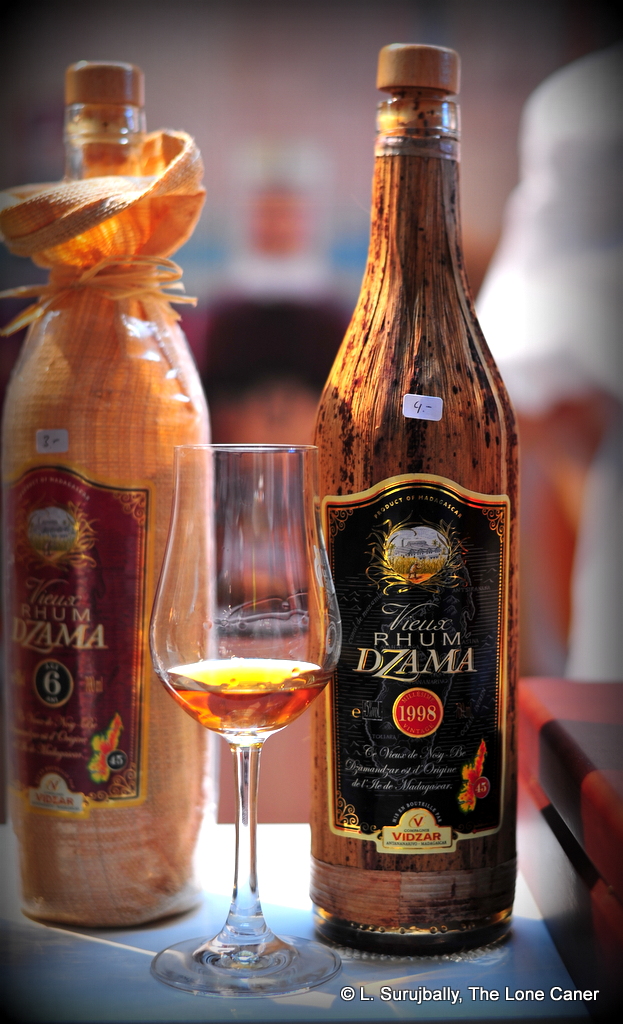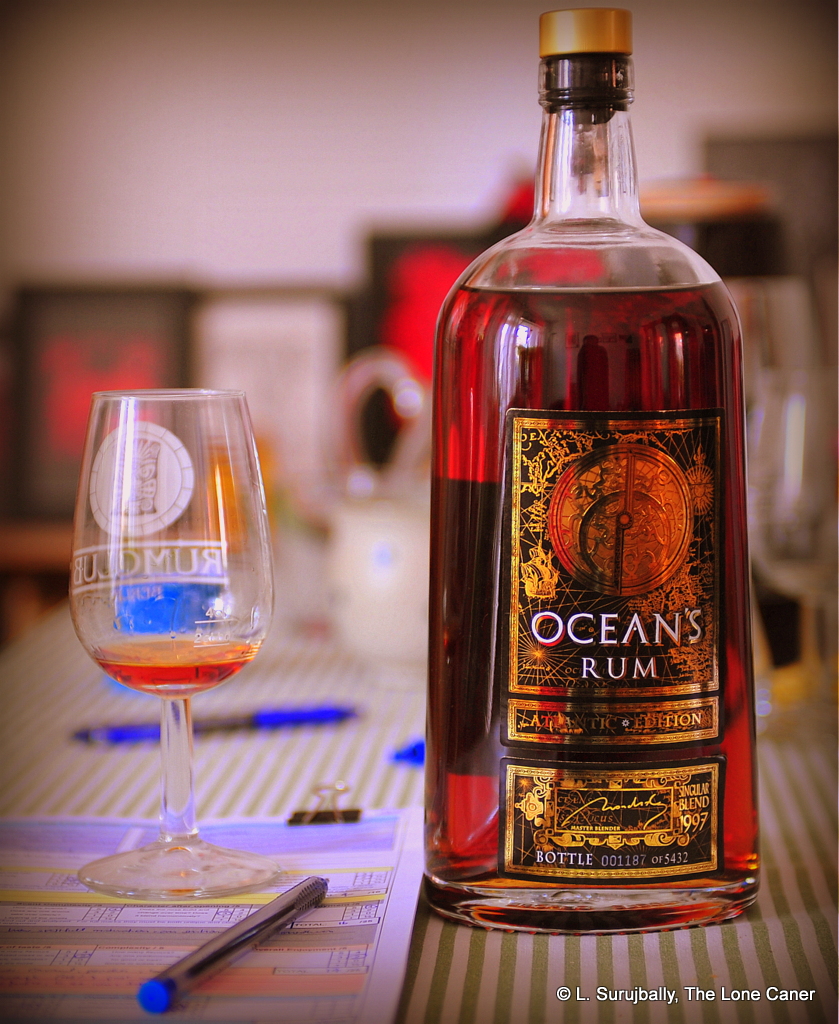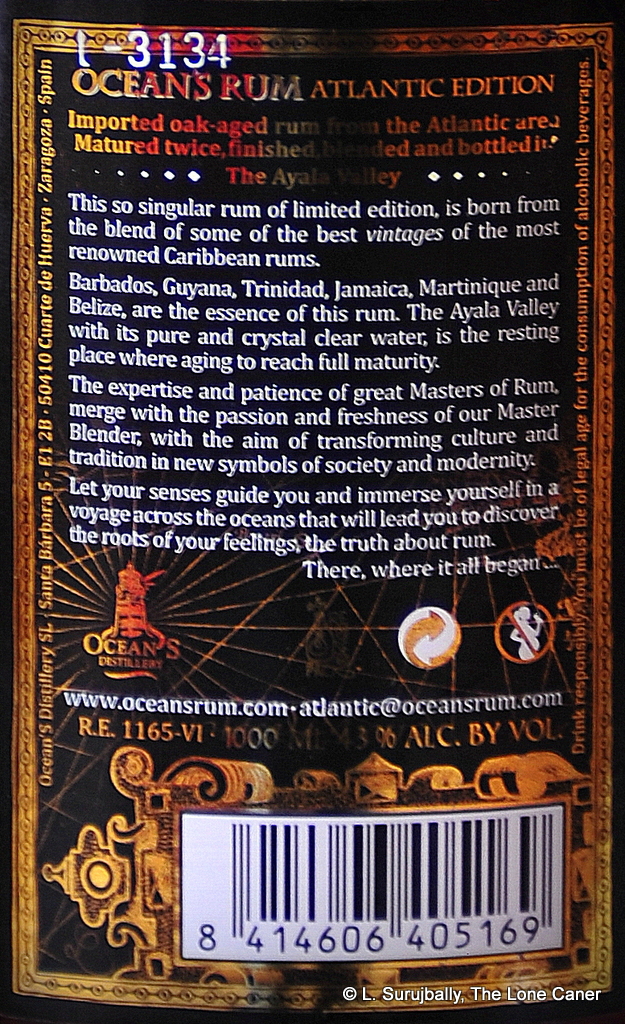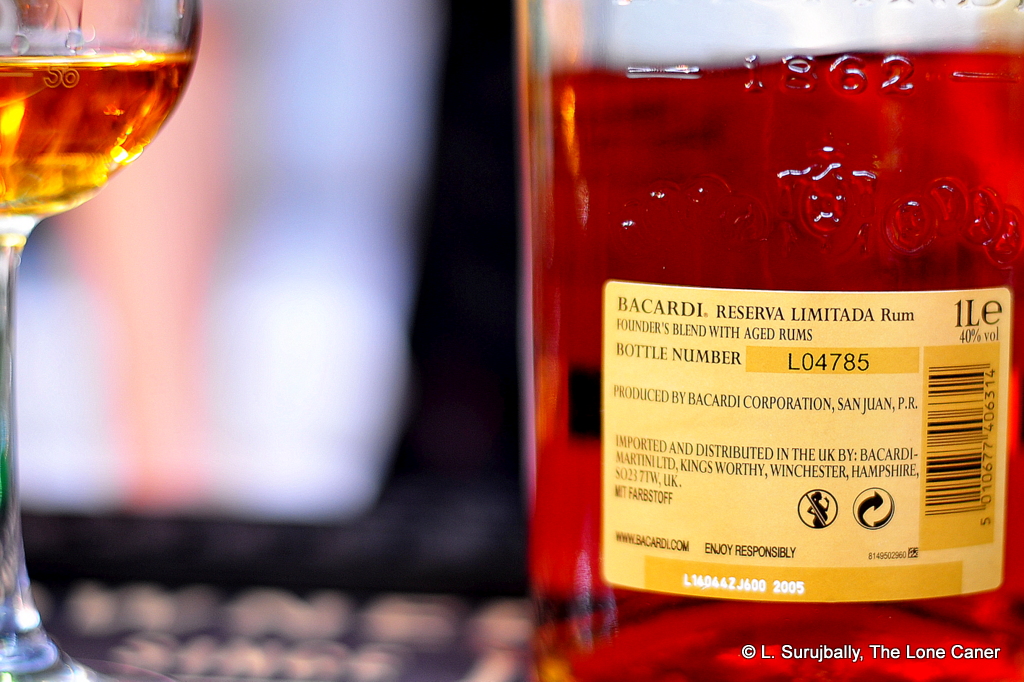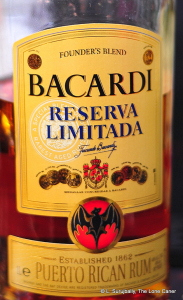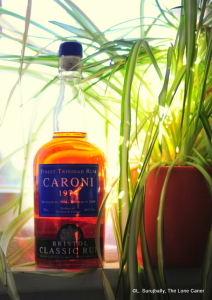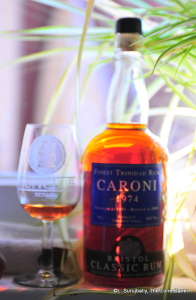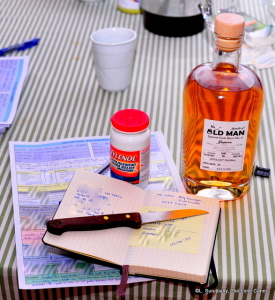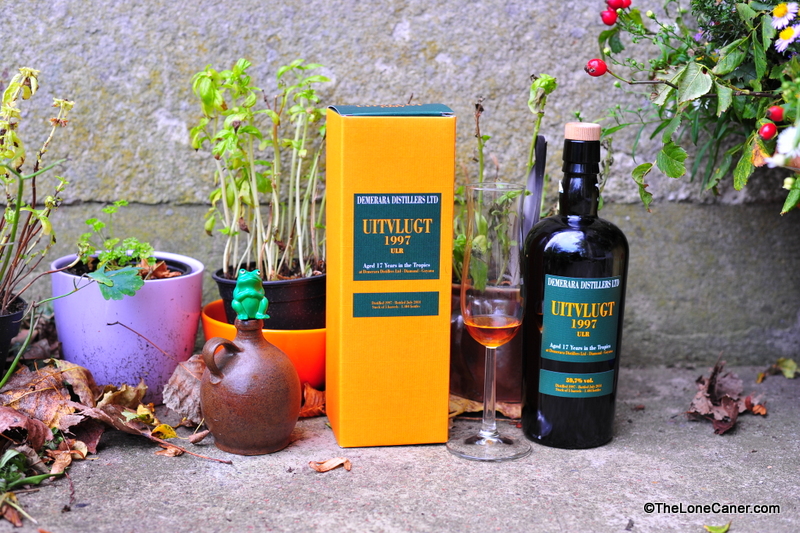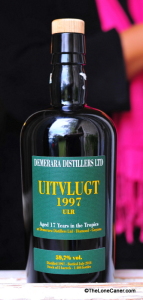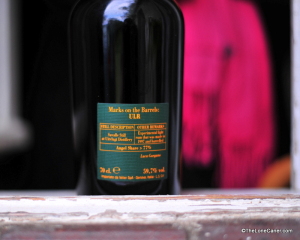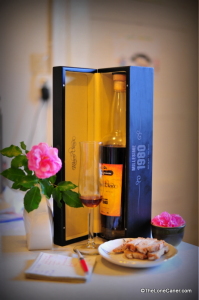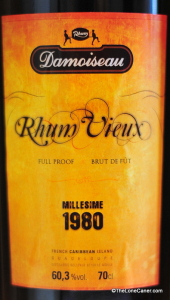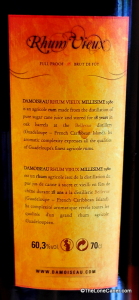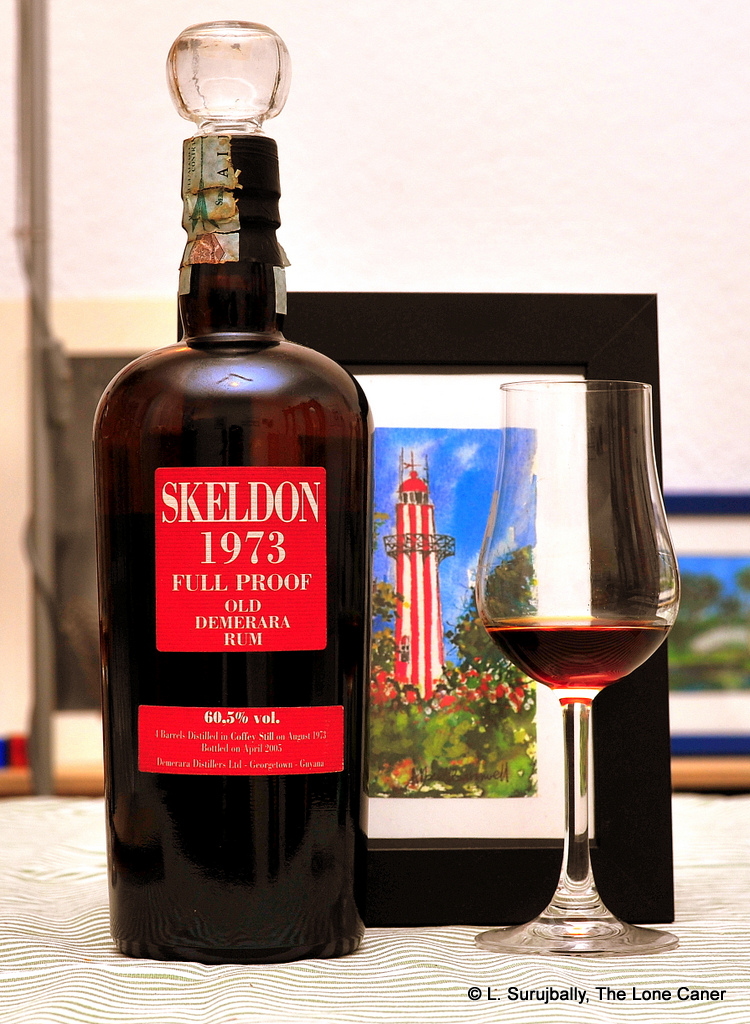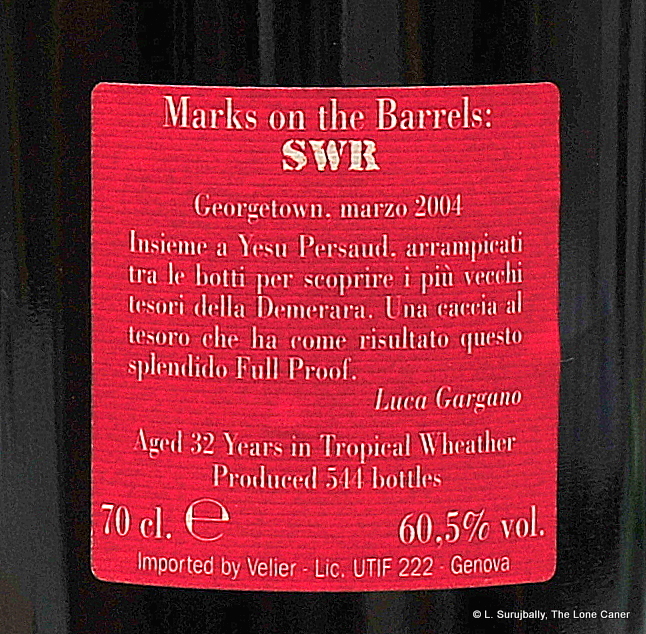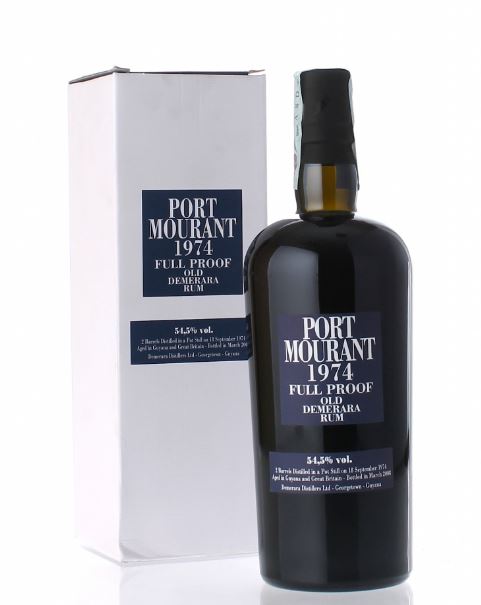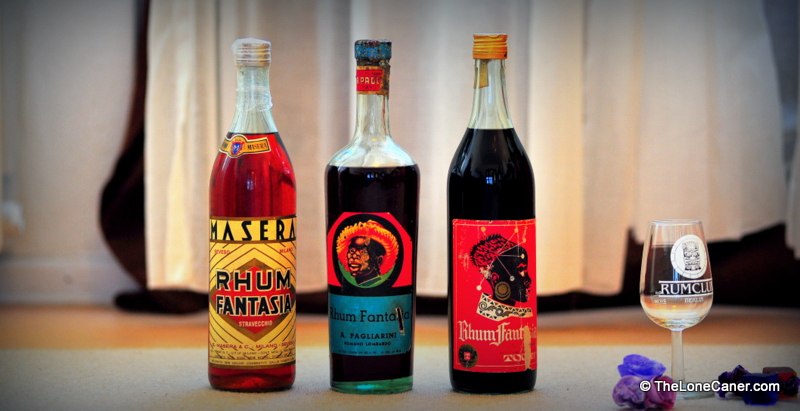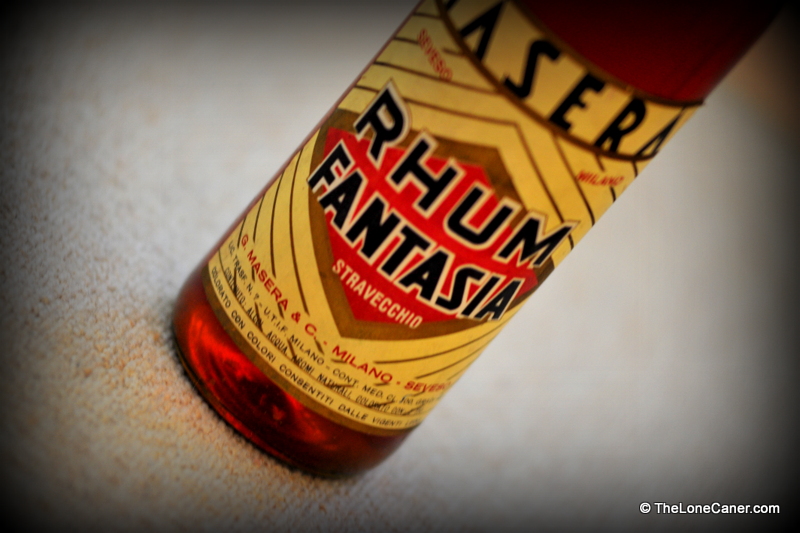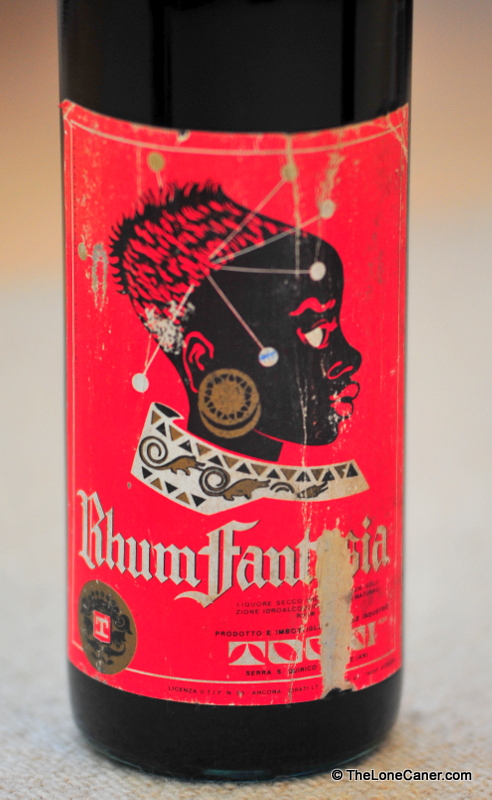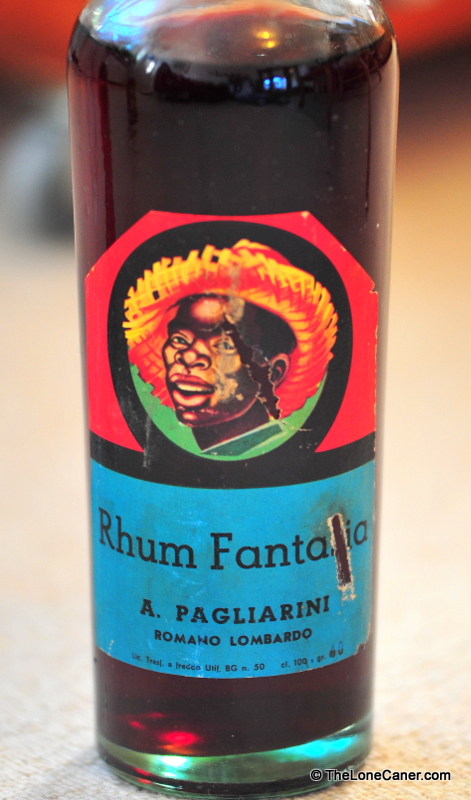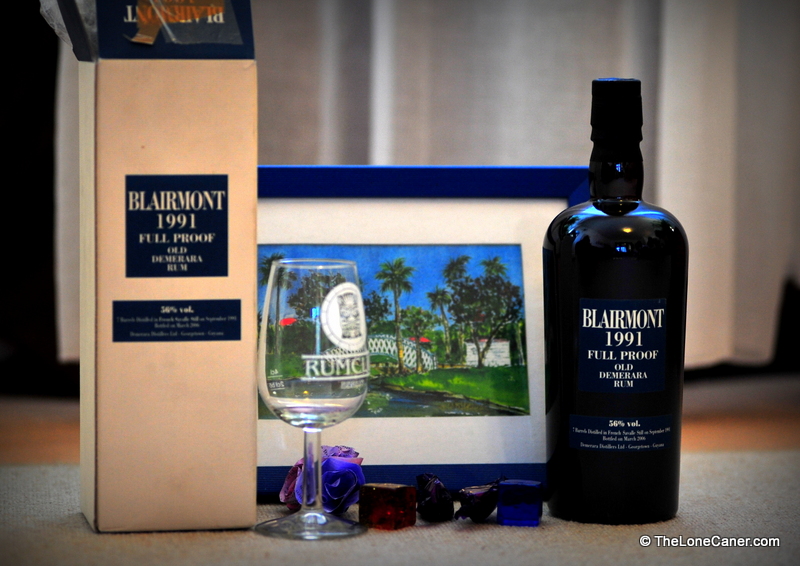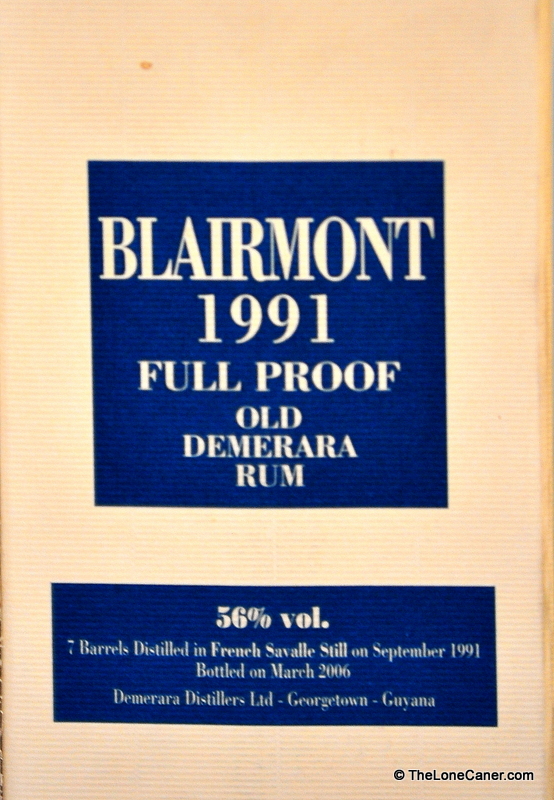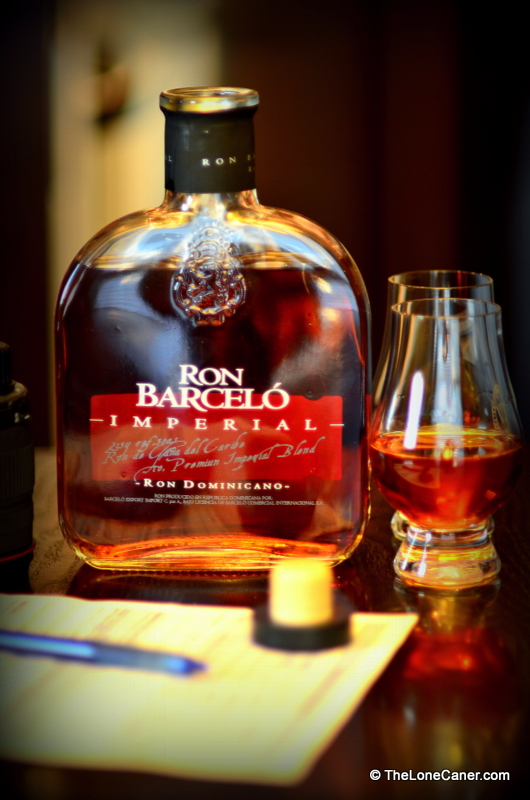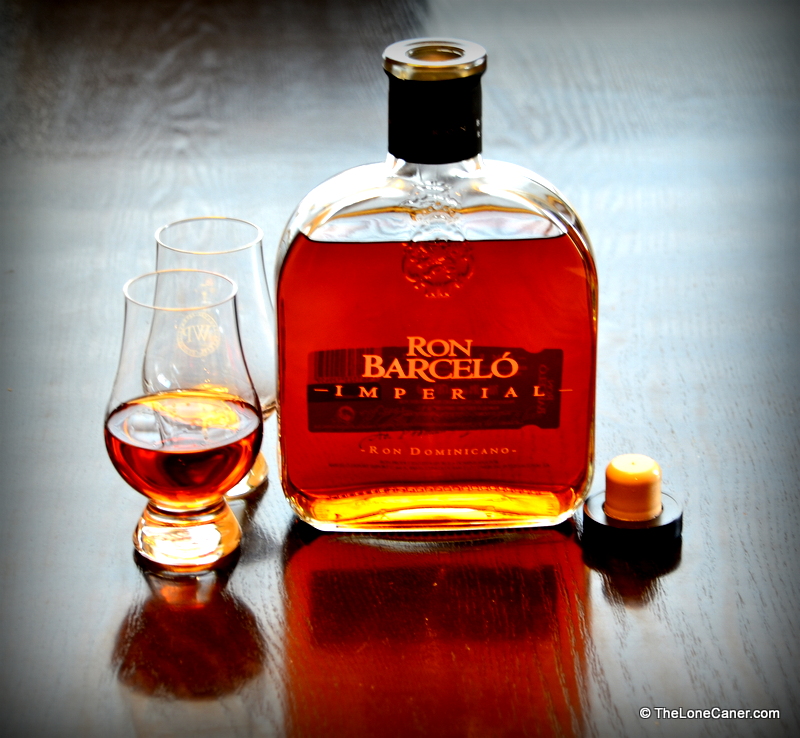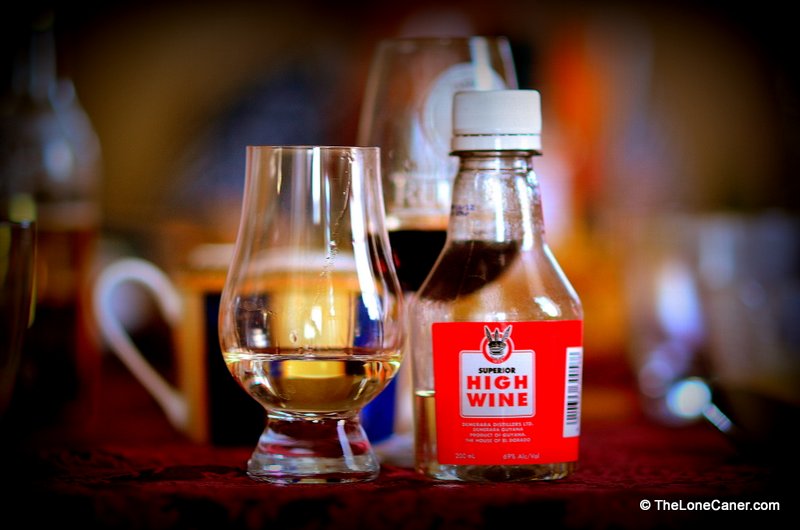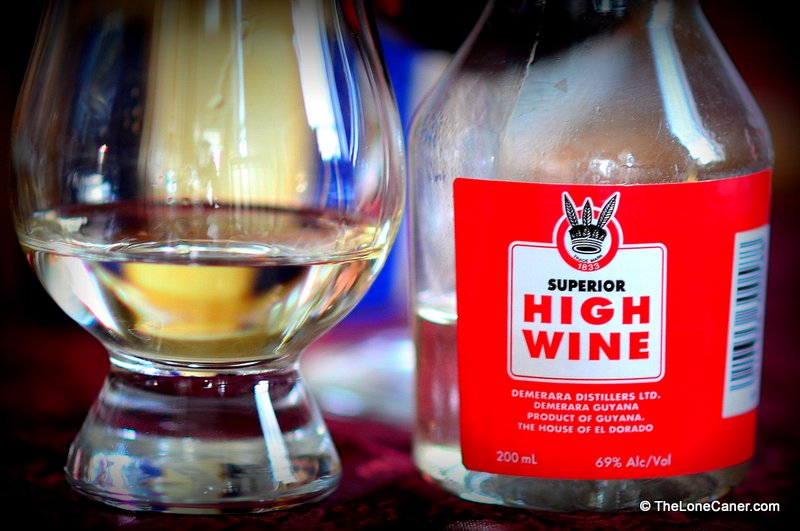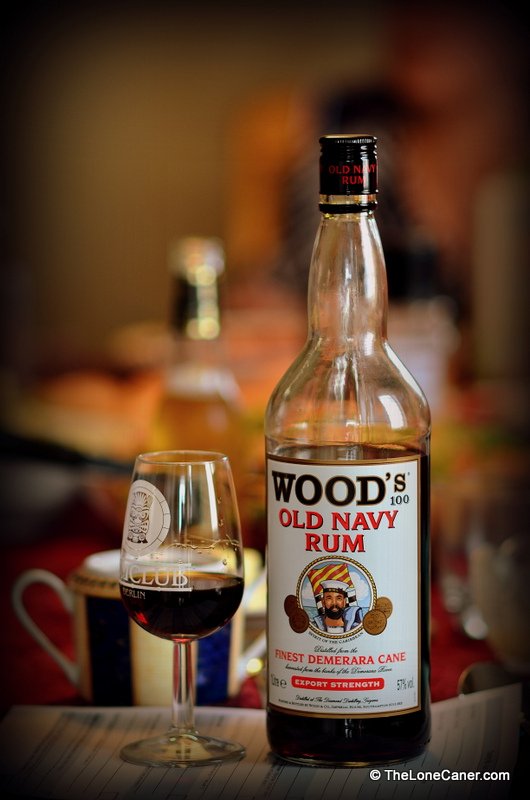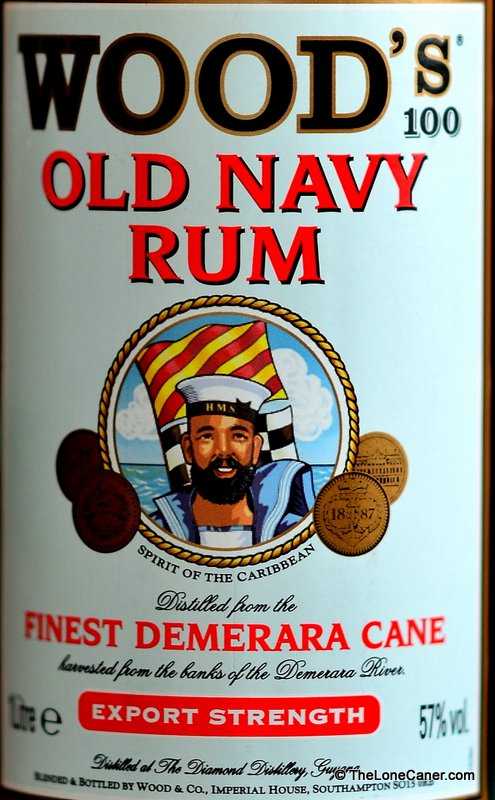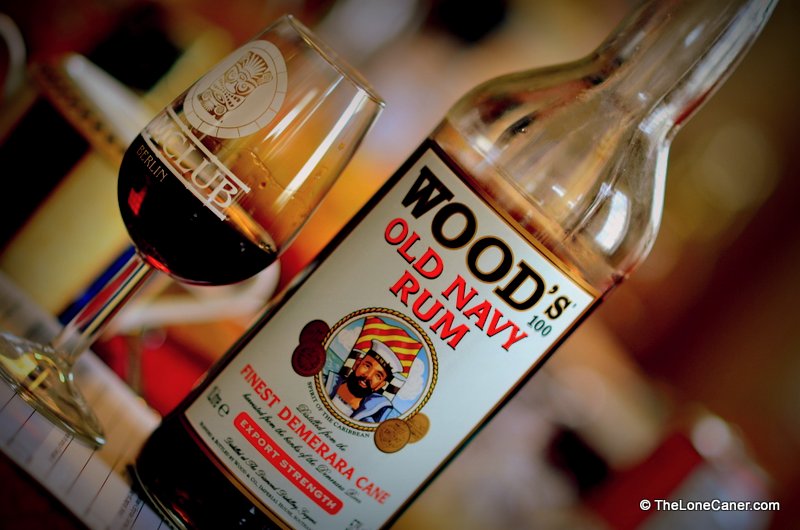
It’s no surprise that I start the “Makers” section of this website with Velier. Perhaps no other company since Rum Nation has so captured my attention the way this one has, and with both it’s about their focus. The scotch makers like G&M, Cadenhead, A.D. Rattray and Bruichladdich also produce year-specific, limited editions of rums, but their product lines are somewhat diluted by not concentrating solely on rums but on the whiskies which are their primary products (at least in my opinion). Velier in contrast has made its name primarily by doing something quite different – they issue all of their products at full proof, and they issue only rums, mostly from Guyana, Trinidad and the French West Indies (see below for other lines of business).
Luca Gargano, the man most closely identified with the company, is a character all by himself. He is an inveterate traveller, photographer, writer and rum lover (to call him an aficionado would be to understate the matter). His stories, delivered with a twinkle in his eye, are the stuff of either bulls**t or legend, and I prefer to believe the latter, just because, y’know, they’re so interesting – for example, there’s the one about how, in service to one of his “five principles,” he doesn’t associate with politicians, and so one time he feigned sickness in Cuba so he wouldn’t have to speak to Fidel Castro. And the other five principles, which he calls privileges? — No watch, no cell phone, no driving and no reading newspapers. So yeah, something of an eccentric, but man, the stories he tells, the way he tells then (he’s truly something of a born raconteur). And he always finishes off by reaching somewhere, fishing out a bottle and a glass and saying “Taste this.”
Luca Gargano began with Velier by buying into the tiny Genoese concern in the early nineteen eighties while he was only 27 – at the time he was the Director of Marketing Spirit SpA, the largest import company in Italy. Even then, his experience as the brand ambassador for St James (from Martinique) during the 1970s infused him with a love for rums. Velier, a small family firm, had been founded by Casimir Chaix back in 1947, and between 1953 and 1983, it became known for importing of wines and spirits to Italy, mostly the north (products included champagne, brandy, even tea and cocoa). Luca began to change the tilt of the company by encouraging the import of spirits particularly targeted at top restaurants and wine bars and developed the image and the distribution of Champagne Billecart-Salmon, which at the time was completely unknown.
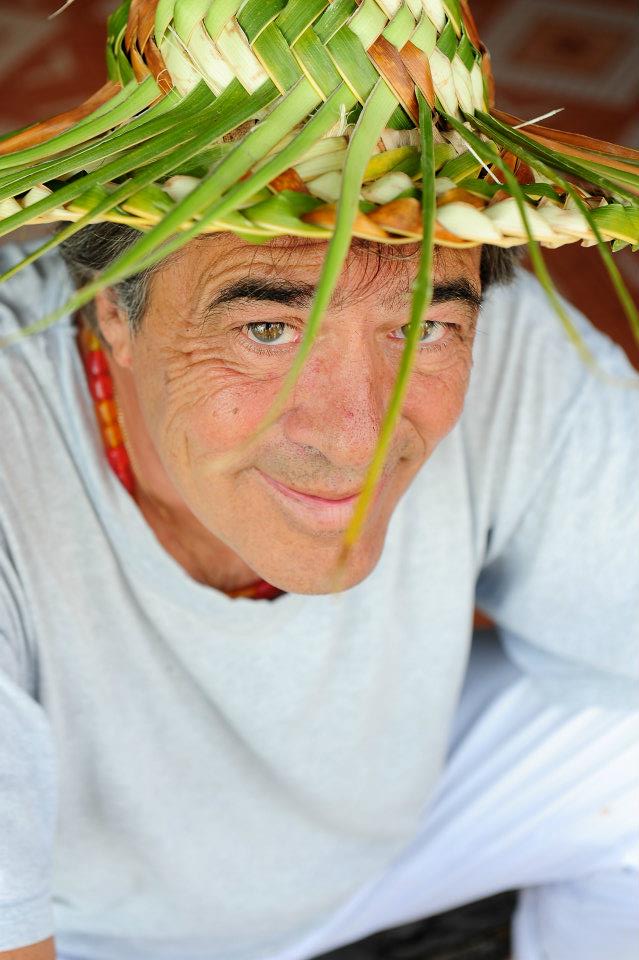
In 1991 Velier developed a line of Latin American White Spirits (cachaca, mezcal, pisco) made to cater to the trendy and ethnic spirits wave which was just gathering steam at the time. The company began its move to craft spirits in 1992 (which I think is the year that the El Dorado 15 year old first appeared), by beginning its selection of barrels of old single malts and rum for its brand. This led, in 1995, to the issuance of several Caribbean rums, riding the wave of the current trend in releasing craft bottling in limited quantities.
Arguably Luca’s earliest coup was to buy almost the entire Damoiseau 1980 output that had been deemed unsell-able because of a proportion of molasses in the rum. He released Velier’s Damoiseau 1980 in 2002 (Damoiseau themselves stole a march on him and issued their own version – they had kept back some of the stock, and as I can attest, that rum is excellent) and he remarked that it was this rum that crystallized his “full-proof” concept, that of issuing rums at natural strength with no dilution whatsoever, and having them fully aged in the tropics.
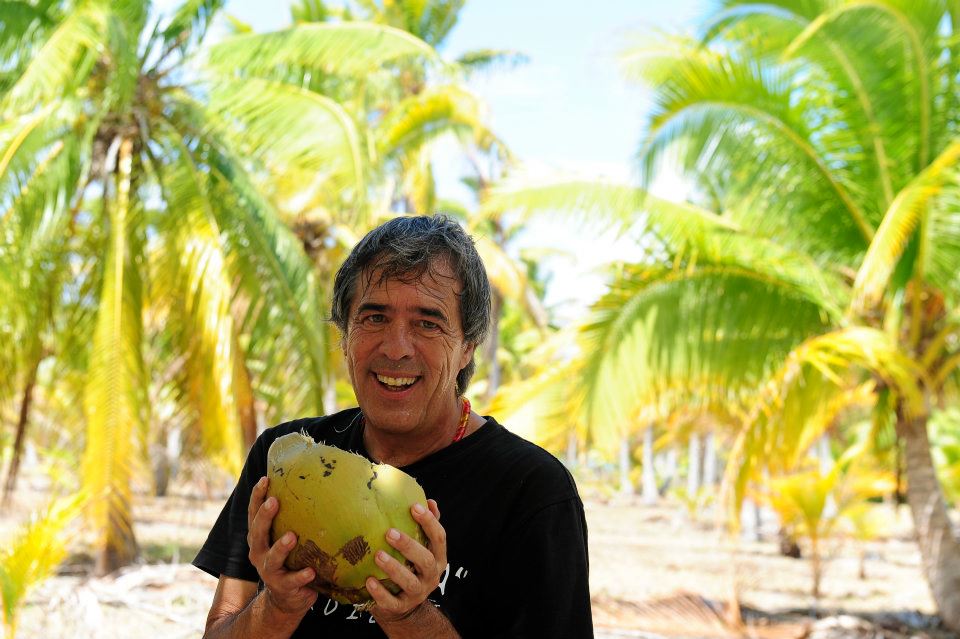
In 2003, after having befriended Yesu Persaud, the chairman of the Guyanese spirits conglomerate Demerara Distillers Ltd, he was given access to very old stocks mouldering away in their warehouses in Diamond – it is my contention that the issuance of these rums has solidified Velier’s name as a company whose bottlings are one of a kind, a company to watch, and whose rare and aged products are really spectacular. Most independent bottlers have the Enmores and Port Mourants as part of the canon, and DDL themselves blend many estate- or still-specific rums into their excellent El Dorado line – but Velier took it one step further, and issued the estate specific rums as rums in their own right: LBI, Blairmont, Versailles, Albion, Skeldon, Port Mourant, Enmore…and all at natural strength. They have, as I remarked in my Skeldon 1973 review, become occasional subjects of cult worship simply due to their rarity (and excellence – I have yet to find a dog in Velier’s line up, and have consistently scored their rums very high). In 2004, Velier bought a tiny stake in DDL, which granted them access to future (and past) rum stocks.
Another series of rums of note which enhanced Velier’s street-cred among rum aficionados was the Caroni line. Caroni was a plantation and distillery in Trinidad, which was shuttered in 2002 (some darkly mutter that it was for crass political reasons), and has a place in rum-lovers’ pantheons which whisky aficionados reserve for Port Ellen. The last stocks of this distillery were supposedly sold at auction in 2003, but in 2004, Velier seems to have snapped up an enormous amount of casks from the 70s, 80s and 90s which they have used to issue several iterations (all full-proof, of course).
Between 2008 and 2014, as Velier’s reputation grew (and maybe as finances and enthusiasm permitted) the company began branching out to other islands and experimenting with distillation and ageing techniques. According to Luca, he had the impulse to produce a rhum agricole with a double distillation, and convinced Mr Vittorio Gianni Capovilla, himself a master distiller (www.capovilladistillati.it) and the Bielle distillery on Marie Galante, to create a new distillery. This was done through Bielle, administratively and legally part of them but operationally independent, apart from the sugar juice supplied by Bielle. The Liberation line (issued under the label RhumRhum) essayed to make agricoles by fermenting the juice without adding water and then double distilling it in copper pot stills. By 2020, this project, after over a decade in operation, was ready to issue the final Liberation release, after which Luca and Capovilla, who had bought the stills, the name and most of the barrels, would transfer operations over to the Pere Labatt distillery, and work as a completely independent enterprise, and (more importantly) a legally separate distillery, from there.
Then there is the Clairin line of Haitian rums, launched in 2012, and more recently there are experimental blends like the 2014 release of PM/ENM, and the Ron Papalin, as well as the 2015 “Still” line from Guyana and Barbados and Jamaica. There are plans to deal in soleras at some point.
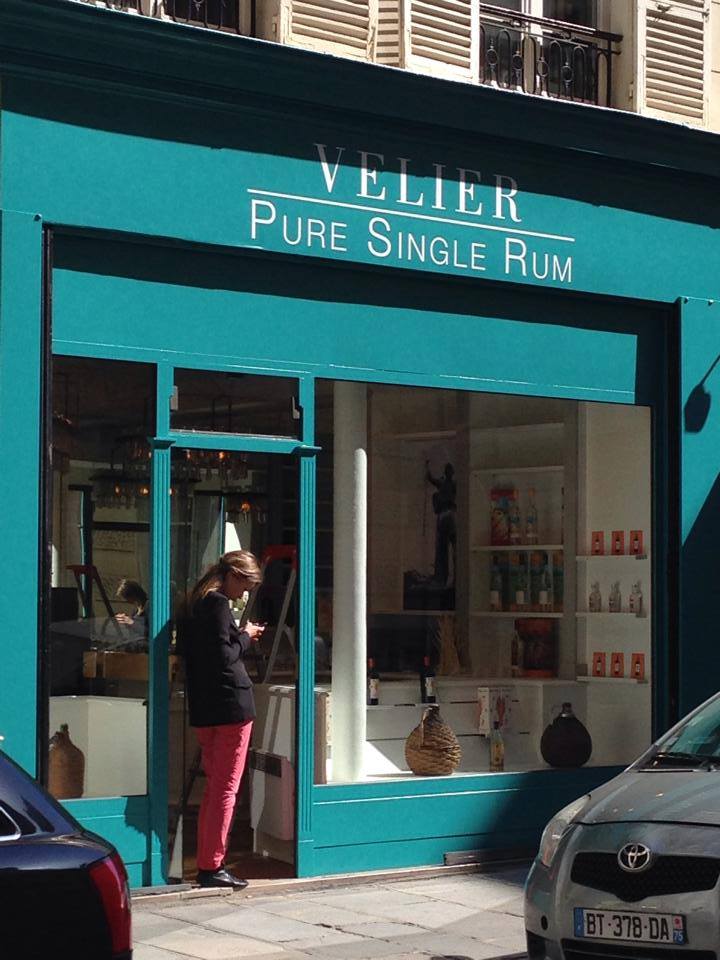
In 2014 Velier opened two shops in Paris, one dedicated to Velier Rhum (the other to Triple A wines). That same year, Luca’s first book “Atlas du Rhum” was published by Flammarion. Velier continues to do more than rums, of course. They are both bottler and importer, yet I argue that it is for their rums they are now primarily known and upon which their fame rests. They might import absinthe, gin and whisky and whatever else – but they make rums. Damned good ones.
Unfortunately, in 2015, it appeared that Velier’s relationship with DDL came to an end, and in spite of being a minority (very minority) shareholder in the company, their unique ability to choose barrels from DDL’s warehouses has ceased. Some call this the end of “The Age of Velier’s Demeraras.” For those who appreciated the Demerara full proofs Velier issued from the famous stills, this was nothing less than a catasstrophic disappointment. Luca branched out, of course – as noted, he has looked into the distribution and promotion of clairins from Haiti, hinting at deepening involvement in non-traditional sources of rum; and in 2015 he issued single estate pot still rums from Jamaica, Guyana and Barbados, as well as investigating the possibilities of Hampden estate in Jamaica for the 2016 release season.
2017 was a great year for Velier, because it was the 70th anniversary of the company, and to commemorate the occasion, Luca pushed a number of new releases out the door – from Barbados, from Jamaica, Mauritius, Japan, Haiti et al (see list below). These became highly sought after rums in their own right, and many others issued in 2016-2017 were issued at young ages, as whites, or to showcase particular distillation apparatuses; many more were done in collaboration with famous houses like Nine Leaves, Chamarel, Hampden and Worthy Park. And no story of such collaborations could be complete without noting the work done with Richard Seale of Foursquare, including the now famous 2006 ten year old and the Triptych rums which were so amazingly popular that they were sold out before actually going on sale online, and required special personalized distribution to hard core fans
As if all this was not enough, in late 2017 Velier announced plans to open an office in New York, to be run by Daniele Biondi (whose name is on several labels of the old Demeraras). Velier is already well known to American rum aficionados, and Daniele’s mission was to raise awareness and build the brand in a country where milquetoast 40% rums of no particular distinction have often relegated cask strength premium rums to the back shelf. The opening of the Velier office in Brooklyn – a partnership between themselves and La Maison du Whiskey – was covered widely on FB, and many of the North American rum “Names” flew in for the occasion. Unsurprisingly, the rums being promoted right off the bat were the Haitian clairins I had such a violent love affair with, and the pot still Habitation Velier collection.
This expansion of Velier’s distribution network was followed in 2018 by the announcement in May that East Coast Liquor in Sydney (Australia) gained the exclusive distribution rights to Habitation Velier rums, in conjunction with promotion by one of the older rum sites in existence, that of Refined Vices (opened in 2007) run by Tatu Kaarlas, a Finn who emigrated down under a decade before. Clearly Velier’s rums were not just a phenomenon of Europe or North America, but were sought after and desired much further field than the traditonal outlets. In September of that year, Velier launched the Hampden range of rums – I’ve heard they bought the entire stock of Hampden’s production for the next two years — by issuing a full proof 60% and one at 46%, at what has become a near legendary Tasting of the Century where in addition to the Hampden launch, four epic rums from ages past were decanted for the fortunate attendees.
As if that was not enough, Velier’s 2018 release slate contained not just a new series of clairins and Caronis, but a series of Jamaican Longpond rums at 60% that tried to showcase the “Wedderburn” and “Continental” styles of rum make from years past. It’s an interesting and welcome departure from better known rum series for Velier, and promises a fascinating new set of rums from that island.
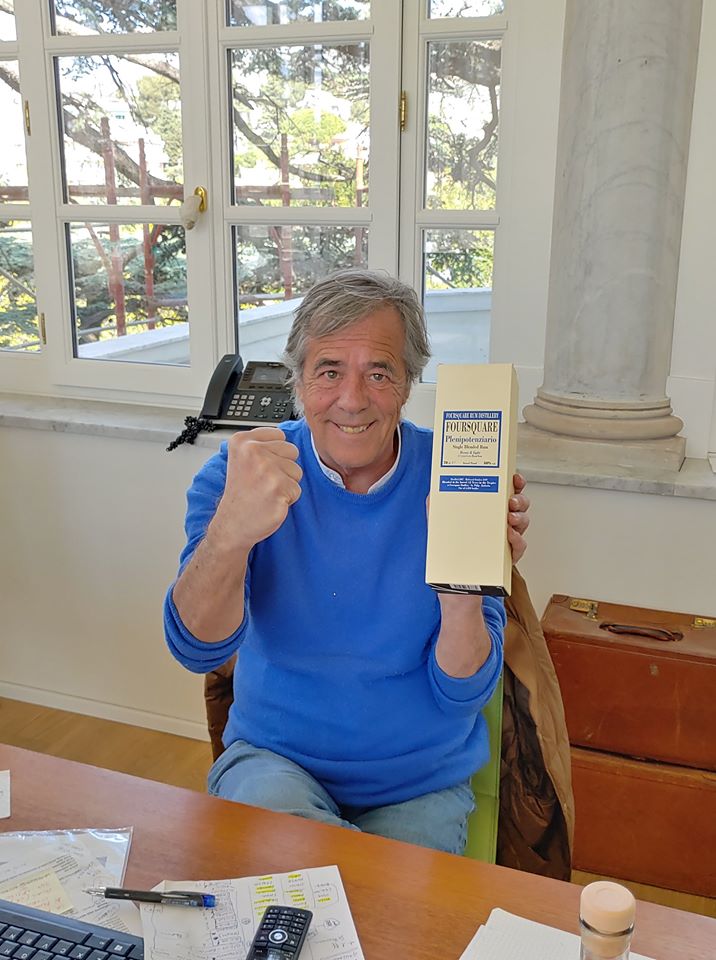
New offices and Plenipotenziario, 2020
These rums were enhanced by a slate of releases in 2019 that showed the wide variety Velier has championed ever since the intitial Demeraras and Caronis that made their name: there were pure rums from Monymusk and Hampden (although not from Worthy Park), Reunion and Mauritius, more Habitation Velier whites and unaged rums, more Caroni “Employee” series rums, and the last barrels of Caroni distillate were bottled in this year. The collaboration with Foursquare continues to yield sought after rums like the Plenipotenziario and Patrimonio and even the move to a new headquarters in Genoa in 2020 has become an occasion to release rums named after the old one.
2020 showed that Velier moved definitively away from the elephants with which its reputation had been made (perhaps there are no more to be found) to smaller and more distinct bottlings of exacting selection. An arrangement with Neisson was negotiated that would allow Neisson rums to become part of the Velier outturn, and three special Appleton pot-still-only rums from 1994, 1995 and 1999 were selected for bottling in that year (and two more in 2021). On top of this there was the ever-expanding lineup of Habitation Velier rums (which I term “educational” with good reason) – Privateer from the USA was one such, and other rums from around the Caribbean and even wider afield are rumoured. This is not even counting more standard “black-bottle” releases like those from Karukera, Nine Leaves and Savanna HERR, an 8 YO Hampden, another Chamarel from Mauritius and a Monymusk 2007 13 YO….and perhaps most intriguingly, a Providence white rum from Port au Prince (Haiti), distilled by Herbert Linge de Barbancourt (from Muller stills), and something I looked forward to myself, one of 1200 bottles of the near mythical Rivers Antoine distillery from Grenada.

Given the reputation Velier has now amassed elsewhere in the world, there is no doubt that the future of their bottlings remains a dynamic one. Because Luca does like to push the boundaries, and his passion has been remarked on by many who have met the man. I don’t imagine I’ll ever get them all – he’s issuing them too fast, and my wallet can’t keep pace (a complete set of every Velier Caroni ever issued was once advertised for sale by an Italian gent for two thousand Euros (utterly unthinkable now), a single bottle of the Skeldon 1978 sold on Ebay for €1,200 in early 2015, and a twin set of the 1973 and 1978 was going in 2016 for €8,000, which gives you an indication of what acquiring the entire canon would entail). Yet I’ll keep trying, as many others will, because Luca’s one of the few in the rum making world who keeps raising the bar for aged, powerful and unique rums that will not be seen again.
And if his name is now known more widely than before 2012 when I and others first began writing about his rums, perhaps it was inevitable that the concussive blast of his earlier work has now been replaced by smaller explosions of high quality, original rums, whose releases are eagerly awaited by those who love his work.
Below is a list of all Velier products of which I am aware, ordered by location and date of distillation (not issue). It’s as exhaustive as I could make it, a good starting point, and I have updated it constantly. Links relate to reviews I’ve written…and yeah, they look as lonely as a few camels in the Sahara, but them’s the breaks.
Guyana
- Albion 1983 17 YO (1983 – 2000) 40% (Breitentein)
- Albion 1983 25 YO (1983 – 2008), 46,7% vol.
- Albion 1984 18 YO (1984 – 2002), 46% vol.
- Albion 1986 25 YO (1986 – 2011), 60,6%vol.
- Albion 1989 19 YO (1989-2008), 62,7% vol.
- Albion 1994 17 YO (1994 – 2011), 60,4%vol.
- Blairmont 1982 28 YO (1982 – 2010), 60,4% vol.
- Blairmont 1991 15 YO (1991 – 2006), 56% vol.
- Diamond 1975 20 YO (1975 – 1996), 40% vol (Thompson & Co)
- Diamond 1975 20 YO (1975 – 1996), 46% vol (Thompson & Co)
- Diamond 1981 31 YO (1981 – 20012), 60.1%vol.
- Diamond 1982 20 YO (1982 – 2002), 46% vol.
- Diamond 1988 18 YO (1988 – 2006), 56%vol.
- Diamond 1993 12YO (1993 – 2005), 61,4% vol.
- Diamond 1996 15YO (1996 – 2010), 64,6% vol.
- Diamond 1999 15YO (1999 – 2014), 53,1% vol.
- Diamond 1999 15YO (1999 – 2014), 64.1% vol
- Enmore 1987 13 YO (1987 – 2000), 56,6% vol. (Breitenstein)
- Enmore 1988 19 YO (1988 – 2008), 51,9% vol.
- Enmore 1990 18 YO (1990 – 2008), 61% vol.
- Enmore 1995 16 YO (1995 – 2011), 61,2% vol.
- Enmore 1998 9YO (1998 – 2007), 64.9% vol.
- La Bonne Intention (1985-2000), 40% vol. (Breitenstein)
- La Bonne Intention 1998 9YO (1998 – 2007), 55,6% vol.
- Port Mourant 1972 35 YO (1972-2008) 47,8% vol.
- Port Mourant 1974 34 YO (1974 – 2008) 54,5% vol.
- Port Mourant 1975 32 YO (1975 – 2008) 56,7% vol.
- Port Morant 1982 20YO (1982 – 2002), 46% vol.
- Port Mourant 1985 21YO (1985 – 1996) 40% vol. (Thompson & Co.)
- Port Mourant 1993 13 YO, (1993 – 2006) 65%vol.
- Port Mourant 1997 15 YO (1997 -2012), 65,7% vol.
- Skeldon 1973 32 YO (1973 – 2005) 60,5% vol.
- Skeldon 1978 27 YO (1978 – 2005) 60,4% vol.
- UF30E (Uitvlugt) 1985 27 YO (1985 – 2012), 60,7%vol.
- Uitvlugt 1985 21 YO (1985 – 2006), 66% vol.
- Uitvlugt 1988 17 YO (1988 – 2005), 52,9% vol.
- Uitvlugt 1990 17 YO (1990 – 2008), 66% vol.
- Uitvlugt 1996 18 YO (1996 – 2014) )modified GS), 57.2%
- Uitvlugt 1997 17 YO (1997 – 2014), 59,7% vol.
- Versailles 1991 5 YO (1991 – 1996), 40% vol. (Thompson & Co)
- Versailles 1998 9YO (1998 – 2007), 46,5% vol.
Trinidad – Caroni
- Caroni 1974 Heavy 34 YO (1974 – 2008), 66.1%
- Caroni 1982 Light 23 YO (1982 – 2005), 59.2%
- Caroni 1982 Light 24 YO (1982 – 2006), 55.2%
- Caroni 1982 Light 24 YO (1982 – 2006), 56.4%
- Caroni 1982 Heavy 24 YO (1982 – 2006), 58.3%
- Caroni 1982 Heavy 23 YO (1982 – 2005), 62%
- Caroni 1982 Heavy 23 YO (1982 – 2005), 77.3%
- Caroni 1983 Extra Strong 110° Proof 17 YO, 55%
- Caroni 1983 Heavy 22 YO (1983 – 2005), 55%
- Caroni 1983 High Proof Heavy 22 YO (1983 – 2005), 52%
- Caroni 1984 Heavy 22 YO (1984 – 2006), 54.6%
- Caroni 1984 Heavy 24 YO (1984 – 2008), 59.3%
- Caroni 1985 Old Legend 15 YO (1985 – 2006), 43.4%
- Caroni 1985 Blended 20 YO (1985 – 2005), 49.5%
- Caroni 1985 Heavy 21 YO (1985 – 2006), 58,8% vol.
- Caroni 1985 Heavy 20 YO (1985 – 2005), 62% vol.
- Caroni 1985 Heavy 20 YO (1985 – 2005), 75.5%
- Caroni 1988 Blended 20 YO (1988 – 2008) 43%
- Caroni 1989 Heavy 16YO (1989 – 2005), 62%
- Caroni 1989 Light 17YO (1989- 2006), 64.2%
- Caroni 1991, 66%
- Caroni 1991 Blended 19YO (1991 – 2010), 55%
- Caroni 1991 Blended 15 YO (1991 – 2006) 43.4%
- Caroni 1992 Heavy 20 YO (1992 – 2012) , 60.2%
- Caroni 1992 Heavy 20 YO (1992 – 2012), 55%
- Caroni 1993 Blended 17 YO (1993 – 2010), 44.4%
- Caroni 1994 Heavy 18YO (1994 – 2012), 55%
- Caroni 1994 Heavy 18YO (1994 – 2012), 62.6%
- Caroni 1994 High Proof 17 YO (1994 – 2011), 52%
- Caroni 1994 Heavy 23 YO (1994-2017) “Guyana Stock” 61%
- Caroni 1994 Heavy 23 YO (1994-2017) “Guyana Stock” 59%
- Caroni 1994 Heavy 23 YO (1994-2017) “Guyana Stock” 59.8%
- Caroni 1994 Heavy 23 YO (1994-2017) “Guyana Stock” 57.18%
- Caroni 1995 Heavy 22 YO (1995-2018) (Cask 3812)
- Caroni 1996 Heavy 17 YO (1996 – 2013) 55%
- Caroni 1996 Heavy 17 YO (1996 – 2013) 63%
- Caroni 1996 Heavy 20 YO (1996 – 2016) 70.8% “Fire” (Cask R3721)
- Caroni 1996 Heavy 20 YO (1996-2016) 70.8% “Legend” (Cask R3718)
- Caroni 1996 Heavy 20 YO (1996 – 2016) 62.4% (Cask 5623)
- Caroni 1996 Heavy 20 YO (1996 – 2016) 70.1% “Trespassers will be Prosecuted”
- Caroni 1996 Heavy 20 YO (1996 – 2016) 57.18% “100 Proof”
- Caroni 1996 Blended 21 YO (1996 – 2017) 61.3%
- Caroni 1996 Blended 21 YO (1996 – 2017) 65.1%
- Caroni 1996 Blended 21 YO (1996 – 2017) 59.8%
- Caroni 1996 Blended 21 YO (1996 – 2017) 64.3%
- Caroni 1996 “Trilogy” Heavy (1996 – 2016) 70.28%
- Caroni 1996 Blended 21 YO (1996-2017) Extra Strong 100º “Imperial Proof”
- Caroni 1997 20YO (1997 – 2017) 61.9%
- Caroni 1998 Extra Strong 104° Proof 15 YO (1998 – 2013), 52%
- Caroni 1998 Blended 17 YO (1998-2015) Extra Strong 110° Proof 55%
- Caroni 2000 100% 12 YO (2000 – 2012), 50%
- Caroni 2000 “Millenium” Extra Strong 120° Proof, 60%
- Caroni 2000 High Proof (2000-2017) 55%
- Caroni 2000 Heavy (2000-2017) 68.4% “Caroni Lit/Alc 2000” (Cask R4002)
- Caroni 2000 15YO Heavy Single Cask (2000 – 2015) 70.9% “Licensed to Sell Spirit…” (Cask 4681)
- Caroni 2017 70th Anniv Edition Blended 21 YO (1996 – 2017) 65.1%
- Caroni 2017 70th Anniv Edition Heavy 21 YO (1996 – 2017) 64.3%
- Caroni 2017 70th Anniv Edition Heavy 23 YO (1994 – 2017) 59.8%
- Caroni “Employees” 1st Release Dennis “X” Gopaul 20 YO (1998-2018) 69.5%
- Caroni “Employees” 1st Release John “D” Eversley 22 YO (1996-2018) 66.5%
- Caroni “Employees” 2nd Release Kevon “Slippery” Moreno 21 YO (1998-2019) 69.5%
- Caroni “Employees” 2nd Release David “Sarge” Charran 23 YO (1996-2019)
- Caroni “Employees” 3rd Release Vijay “Vijay” Ramnarine (1996-2020) 65.3%
- Caroni “Employees” 3rd Release Nita “Nitz” Hogan (2000-2020) 65.9%
- Caroni “Employees” 3rd Release Ramesh “Buju” Ramgobie (1998-2020) 66.9%
- Caroni “Employees” 4th Release Basdeo “Dicky” Ramsarran (2000-2020) 64.3%
- Caroni “Employees” 4th Release Balas “Brigade” Bhaggan (1998-2020) 68.4%
- Caroni “Employees” 4th Release Dayanand “Yunkoo” Balloon (1998-2020) 68.3%
- Caroni “Employees” 5th Release Deodat “Breeze” Manmohan (1996-2021) 66.7%
- Caroni “Employees” 5th Release Dhanraj “Dan” Maharaj (1996-2021) 66.3%
- Caroni “Employees” 6th Release Caroni Employees “United” (1996-2021) 66.6%
- Caroni “Employees” 6th Release Mahesh “Sonny Black” Bridgelal (1996-2021) 64.6%
- Caroni “Employees” 6th Release Ricky “Dirty Harry” Seeharack (1996-2021) 66.2%
- Caroni “The Last Caroni” Full Proof Heavy 23 YO (1996-2019) 61.9%
- Caroni “The Tasting Gang” Full Proof Blended 23 YO (1996-2019) 63.5%
Marie Galante & Capovilla
Barbados
- Foursquare Plenipotenziario 12 YO (2007-2019) Single Blended Rum (ex Bourbon) 60%
- Foursquare Patrimonio 15YO (2004-2019) Single Blended Rum (ex Bourbon/Ex Sherry) 58%
- Foursquare Destino 14 YO (2013-2017) Single Blended Rum
- Foursquare Destino 14 YO Velier 70th Anniversary
- Foursquare Triptych ~9 YO 56% Blended Rum (released 2016)
- Foursquare Principia 9 YO (2008-2017) 62%
- Foursquare 2006 10 YO (2006-2016) 62%
True Explorer Series (with LMDW)
- Foursquare “Elliott Erwitt” 15 YO (2005-2020) Single Blended Rum 58%
- Mount Gay “Elliott Erwitt” 13 YO (2007-2020) Pure single Rum 60%
- Saint James “Elliott Erwitt” 14 YO (2006-2020) Rhum Agricole 45%
- Hampden “Elliott Erwitt” 4 YO (2016-2020) Pure Single Rum 60% (HLCF
Indian Ocean Series
Guadeloupe
- Velier Guadeloupe from Courcelles 31 YO (1972 – 2003/5), 54% vol.
- Velier Guadeloupe from Courcelles 31 YO (1972 – 2003), 42% vol.
- Velier Guadeloupe from Montebello Basseterre Rhum Vieux 1995, 58,2% vol.
- Velier Guadeloupe from Montebello Basseterre Rhum Vieux 1997, 49,2% vol.
- Rhum Damoiseau 1980 22 YO (1980 – 2002) 60.3%
- Rhum Damoiseau 1995 11 YO (1995 – 2006), 66,9%
- Rhum Damoiseau 1989 17 YO (1989 – 2006), 58%
- Rhum Damoiseau 1986 15 YO (1986 – 2001) 42% (Cuvee du Millenaire)
- Karukera Rhum Vieux Agricole 2009 11 YO (2009-2020) 58.4%
- Papa Rouyo Brut d’Alembic Rhum Agricole du Terroire 120 days 66.5% (1,130b)
- Papa Rouyo Blanc Mature Rhum Agricole du Terroire 450 days 64% (1,100b)
Jamaica
Longpond
Hampden (distribution arrangement)
- Hampden Estate 8 YO Overproof (2010-2018) 60% (original blend 2018)
- Hampden Estate 8 YO Overproof (2010-2018) 46% (original blend 2018)
- Momymusk EMB Warren Kong Series 24 YO (1995-2019) 67%
- Hampden Jamaica Pure Single Rum OWH 8 YO (2011-2019) (Berlin Bar Convent) 59.5% Cask No. 95
- Hampden Jamaica Pure Single Rum LROK 9 YO (2010-2019) (Salon du Rhum) 63.2% Cask No 215
- Hampden Jamaica Pure Single Rum <H> 9 YO (2010-2019) (LMDW Edition) 69.2% Cask No. 41
- Hampden Jamaica Pure Single Rum OWH 7 YO (2012-2019) (WhiskyLive 2019 Paris) 62.8% Cask No. 299
- Hampden Jamaica Pure Single Rum LFCH 8 YO (2011-2019) (WhiskyLive 2019 Singapore) 61.7% Cask No. 295
- Hampden Jamaica Pure Single Rum HLCF/DOK 9 YO (2010-2019) 61% Cask No. 76
- Hampden Jamaica Pure Single Rum LROK 9 YO (2010-2019) (New York edition) 59% Cask No. 327
- Hampden Jamaica Pure Single Rum C<>H 10 YO (2010-2020) 68.5% (2615 g/hlpa)
- Hampden Old Pure Single Jamaican Rum Distillery Edition – Great House 2020 59.0%
- Hampden Old Pure Single Jamaican Rum Distillery Edition – Great House 2022 55.0%
- Hampden Jamaica Pure Single Rum LROK 5YO (2016-2021) – The Younger (47.0%)
- Hampden Rare Cask Series DOK 12 YO (2010-2022) 63.7%
- Hampden Rare Cask Series HGML 12 YO (2010-2022) 63.6%
- Hampden Rare Cask Series HLCF 12 YO Single Cask 78 (2010-2022) 61.9%
- Hampden Rare Cask Series HLCF 12 YO Single Cask 79 (2010-2022) 62.8%
- Hampden Rare Cask Series HLCF 12 YO Single Cask 80 (2010-2022) 61.3%
- Hampden “Pagos” Sherry-Aged Jamaican Rum (~2018-2021) 52% 1200b
Hampden: Trelawny Endemic Birds Series
- Hampden Jamaica Pure Single Rum 9 YO LROK (2011-2020) 60.3% Cask 296 “Red Billed Streamertail”
- Hampden Jamaica Pure Single Rum 8 YO OWH (2012-2020) 59.9% Cask 662 “Black Bird”
- Hampden Jamaica Pure Single Rum 10 YO LROK (2010-2020) 62.5% Cask 487 “Owl”
- Hampden Jamaica Pure Single Rum 8 YO OWH (2012-2020) 61.7% Cask 667 “Chestnut Bellied Cuckoo”
- Hampden Jamaica Pure Single Rum 10 YO LROK (2010-2020) 62.2% Cask 497 “Woodpecker”
- Hampden Jamaica Pure Single Rum 9 YO LFCH (2011-2020) 60.4% Cask 289 “Peewee”
- Hampden Jamaica Pure Single Rum 8 YO (2012-2020) xx.x% Cask 670 “Euphonia”
Other Jamaicans
- R.A.S.C. (Royal Army Service Corps) Jamaica Rum 1954 (Batch 1 – 2017) 53%
- R.A.S.C. (Royal Army Service Corps) Jamaica Rum 1954 (Batch 2 – 2020) 53%
- MMW Wedderburn Jamaica Vatted Pot Still Rum (Monymusk) 11 YO 69.1% Trop. Age*
- MMW Wedderburn Jamaica Vatted Pot Still Rum (Monymusk) 11 YO 63.9% Cont. Age*
- EMB Plummer Jamaica Vatted Pot Still Rum (Monymusk) 14 YO 69.7% Trop. Age*
- EMB Plummer Jamaica Vatted Pot Still Rum (Monymusk) 14 YO 64.8% Cont. Age*
- Appleton Single Estate Jamaica Rum 100% Pot Still 26 YO (1994-2020) 60%
- Appleton Single Estate Jamaica Rum 100% Pot Still 25 YO (1995-2020) 63%
- Appleton Single Estate Jamaica Rum 100% Pot Still 21 YO (1999-2020) 63%
- Papalin 7 YO Original Vatted Pot Still Rum 47% (WP/Hampden Blend)
- Papalin 7 YO Original Vatted “Navy Proof” Pot Still Rum 57.18% (WP/Hampden Blend)
*Joint bottling between E&A Scheer & Velier Genoa
Haiti
- Clairin Vaval Rhum Agricole, Batch 1 (2012), 48,7%vol.
- Clairin Casimir Rhum Agricole, Batch 1 (2012), 53,7%vol.
- Clairin Sajous Rhum Agricole, Batch 1 (2012), 48,1%vol.
- Clairin Vaval Rhum Agricole, Batch 2 (2014), 52,5%vol.
- Clairin Sajous Rhum Agricole, Batch 2 (2014), 53,5%vol.
- Clairin Sajous Rhum Agricole, Batch 2 (2014), 54%vol.
- Clairin Casimir Rhum Agricole, Batch 2 (2015) 50.2%
- Clairin Casimir Rhum Agricole (Batch unknown) 53.4%
- Clairin Vaval Rhum Agricole (2015) 51.1%
- Clairin Sajous Rhum Agricole (2015) 51.0%
- Clairin World Championship (Blend)(2016) 46%
- Clairin Le Rocher Rhum Agricole (2017) 46.5%
- Clairin Le Rocher Rhum Agricole (2017) 51%
- Clairin Sajous “Ansyen 19 mois” (Jun 2016 – Jan 2018) 53.1%
- Vieux Sajous 2016-2020 4 YO Cask Strength First Release 50.6%
- Vieux Sajous 2017-2022 5YO Ex-Caroni 52.14% (Black bottle, 4700b)
- Papalin Haiti Original Vatted Rum 4 YO 2018-2022 53.1% (black bottle, 6000b)
- Providence Haitian Pure Single Rum “First Drops” specs TBA
- Providence Haitian Pure Single Rum “Dunder & Syrup” specs TBA
- Providence Haitian Pure Single Rum 3 YO 2019-2022 52% (6000b)
Other
- Neisson 1997 47% (Joint bottling with Velier)
- J. Bally 1970 Reserve (with Cantarelli, 1991), Martinique
- West Indies Old Barbados Rum 12 YO (1986 – 1998), 46%
- Savanna Warren Kong Series 20 YO (1999-2019) 57%
- Savanna HERR 2006 14 YO (2006-2020) 63.2%
- Nine Leaves Pure Sugar Cane Juice Rum 2016 4 YO (2016-2020) 66.6%
- Villa Paradisetto – Chamarel 2013-2020
- Villa Paradisetto – Privateer 2017-2020
- Villa Paradisetto – Monymusk 2007-2020
- Neisson Cuvee Velier Chai Vevert #2 4 YO 2016-2020 56.8%
- Neisson Cuvee Velier Chai Mainmain #4 4 YO 2016-2020 54.1%
- Neisson Cuvee Velier Chai adrien #5 4 YO 2016-2020 55.8%
- Isautier Rhum Agricole 16 YO 65% Lot 16/17 ex Bourbon Cask 536 bottles (2004?)
- Isautier Rum Traditionnel 16 YO 65% Lot 38 ex Bourbon Cask 575 bottles (2004?)
- Beenleigh Australian Rum 13 YO (2006-2020) 59% Tropical Ageing
- Beenleigh Australian Rum 5 YO (2015-2020) 59% Desert Ageing
- Amrut Indian Pure Single Rum “Collection Antipodes” 7 YO 2015-2022 65%
Habitation Velier
Velier 70th Anniversary Collaborations (2017 and 2018)
- Karukera 2008 Single Cask 9 YO (2008-2017) 53.4%
- Nine Leaves “Encrypted” Single Cask 4 YO (2013-2017) 65%
- Neisson Rhum Vieux Agricole 12 YO (2005-2017) 51.3%
- Neisson Rhum Vieux Agricole 10 YO (2007-2017) 58.1%
- Velier Royal Navy Very Old Rum 57%
- Chamarel Pure Single Rhum Agricole (2011-2017) 55.5%
- Chamarel Vatted Single Rum (2010-2014) 56.5%
- Caroni 2017 70th Anniv Edition Blended 21 YO (1996 – 2017) 65.1%
- Caroni 2017 70th Anniv Edition Heavy 21 YO (1996 – 2017) 64.3%
- Caroni 2017 70th Anniv Edition Heavy 23 YO (1994 – 2017) 59.8%
- Antigua Distillery 6 YO (2012-2018) 66%
- Pere Labat Distillerie Poisson (2010-2017) Fut 105/106 57.5%
Velier 70th Anniversary “Warren Khong” Series (2017)
- St. Lucia Distillers Single Cask 7 YO (2010-2017) 58.6% (267b)
- Bielle Single Cask 10 YO (2007-2017) 55% (250b)
- Chamarel Two-Cask Blend 6 YO (2011-2017) 55.5% (249b)
- Nine Leaves Encrypted Single Cask 3 YO (2014-2017) 64.8% (249b)
- Mount Gilboa Three-Cask Blend 9 YO (2008-2017) 66% (1632b)
- Hampden <H> Five-Cask Blend 7 YO (2010-2017) 62% (1659b)
Sources
